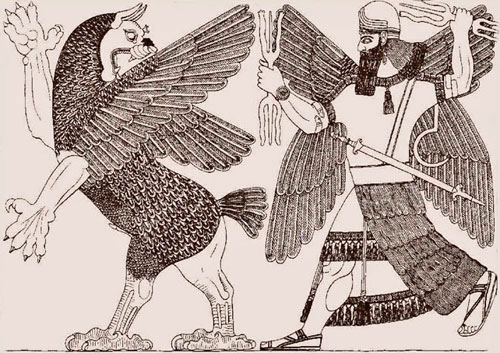|

Sep 28, 2004

One of the most profound archetypes of the early cultures is also
among the most enigmatic. Every culture recalled the ancient combat
between a great warrior and a monster whose attack threatened to
destroy the world. Pictured above is the lion-headed beast Anzu
remembered by the Sumerians, Babylonians, and
Assyrians - a fierce
monster defeated (in various tales) by the Sumerian Ningirsu or the
Babylonian Ninurta or Nergal. The warrior confronting
Anzu in the
above picture is the god Ninurta, wielding in each hand a weapon
identified as a "thunderbolt".
As for explanations, historians can only offer contradictory
guesses. How did the story of a heaven-altering contest find its way
into so many cultures? In the ritual of the Babylonian Akitu
Festival, the enemy is the dragon Tiamat, subdued by the god
Marduk.
For the Egyptians it was the dragon Apep, defeated by
Ra or his
agent Horus. For the Greeks it was the fiery serpents
Typhon or
Python, vanquished respectively by Zeus and
Apollo. Hindu accounts
similarly recalled the attack of the sky-darkening serpent Vritra,
felled by Indra. But these are only a few of hundreds of such
accounts preserved around the world.
The story typically begins with the monster's arrival, an event
signifying universal catastrophe. A legendary warrior sets out to
engage the monster in direct combat. The battle rages amid
earthquake, fire, wind, and falling stone, and it appears that all
will be lost. Then the hero's magical weapon, fashioned by gods or
divine assistants, flies between the combatants, turning the tide of
battle and vanquishing the monster.
From this primeval encounter, the warrior earned his title as
"hero". He defeated chaos and saved the world from catastrophe. But
how did the divine weapon accomplish this feat? The storytellers'
own words and symbols, when traced to root meanings, make clear that
the hero's weapon was no ordinary sword, arrow, or club. It was a
thunderbolt - and not the familiar lightning of a regional storm, but
a bolt of cosmic dimensions. Though this original identity may not
be apparent in many of the later versions of the story, it can be
established reliably through cross-cultural comparison, with close
attention to the memory's more archaic forms. When the great
civilizations of the ancient world arose, the monster, the
hero, and
the cosmic thunderbolt already dominated human consciousness.
For the proponents of the Electric Universe, the role of the
thunderbolt in the more ancient accounts is a vital clue, one to
which we shall return frequently in these pages. Why does the divine
thunderbolt not look like the lightning known to us today? As we
intend to show, the unusual forms of this weapon can serve as a
bridge between plasma science and historical inquiry. The forms of
the divine thunderbolt were not accidental. To an astonishing extent
they mimic the configurations taken by intense electric discharge in
the plasma laboratory. And now, thanks to modern telescopes, we see
similar forms in remote space, a fact that can only reinforce the
power of the ancient message.
|
